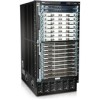Dell PowerConnect J-8216 Hardware Guide - Page 106
W / 2000 W
 |
View all Dell PowerConnect J-8216 manuals
Add to My Manuals
Save this manual to your list of manuals |
Page 106 highlights
Dell PowerConnect J-Series J-EX8216 Ethernet Switch Hardware Guide 3. Calculate the required number of power supplies (N) needed to meet the total power requirement by dividing the total power requirement by the output wattage of one power supply and then rounding up. For example, for a switch fully loaded with 8-port SFP+ line cards and using N+1 power redundancy with 2000 W power supplies, the required power supplies (N): = (total power requirement) / (output wattage of power supply) = (9600 W) / (2000 W) = 4.8 = 5 (rounded up) For a switch fully loaded with 8-port SFP+ line cards, using N+N power redundancy with 3000 W power supplies, the required power supplies (N): = (total power requirement) / (output wattage of power supply) = (9000 W) / (3000 W) =3 4. Add the number of power supplies needed to achieve the required power redundancy: • To achieve N+1 power redundancy, add a single power supply. For example, for a switch fully loaded with 8-port SFP+ line cards and using 2000 W power supplies, the total number of power supplies: =N+1 =5+1 =6 • To achieve N+N power redundancy, add N power supplies. For example, for a switch fully loaded with 8-port SFP+ line cards and using 3000 W power supplies, the total number of power supplies: =N+N =3+3 =6 90















